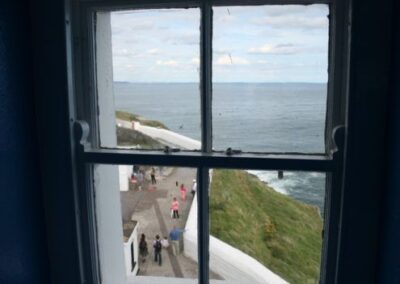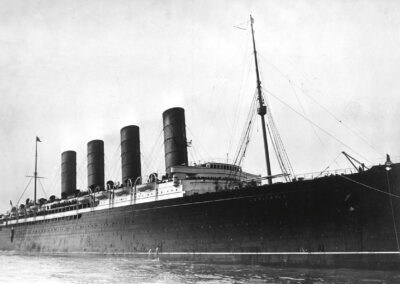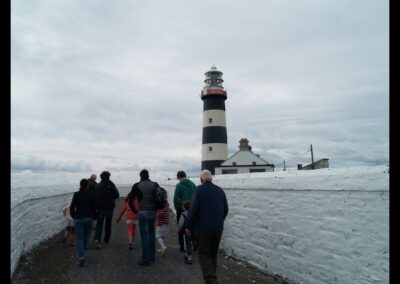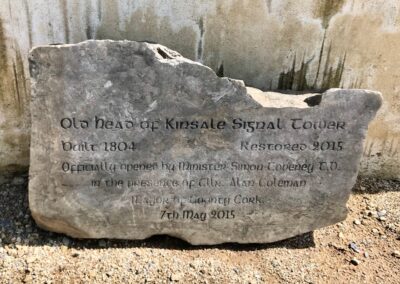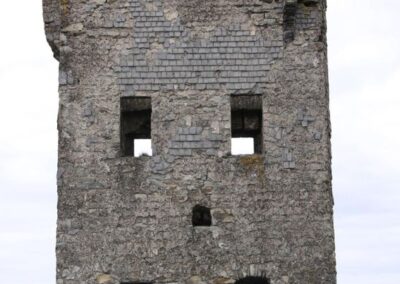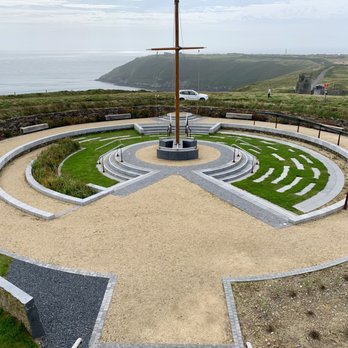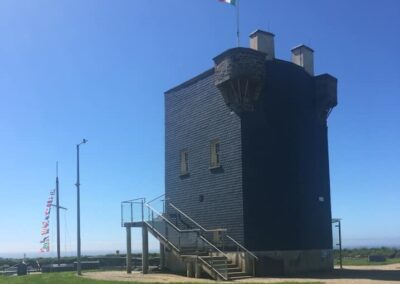
The Old Head Signal Tower
The Old Head of Kinsale Signal Tower, built at the highest point of one of the most prominent peninsulas off Ireland’s south coast, is just over 200 years old. It was built during the Napoleonic wars in response to the threat of a French invasion. There were 81 such towers with line-of-sight visibility from one to the next. Following the failed 1796 French invasions, these watch towers were built between 1804 and 1806 on prominent headlands along the east, south and west coats of Ireland stretching from Dublin to Malin Head County Donegal. The Old Head Signal Tower is No. 25.
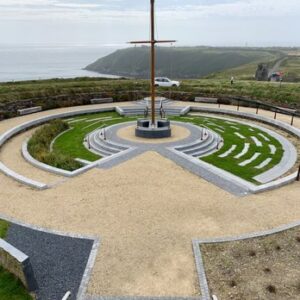 The Old Head Signal Tower is currently being used to showcase a small number of artifacts from the RMS Lusitania and items relating to her sinking, including original newspapers announcing the German torpedoing of the Lusitania. The Old Head Signal Tower serves only as a small de facto museum, housing several precious artefacts recovered in recent years from the wreck, but of its nature the space is very limited and there are many more Lusitania artefacts to be displayed in a proper setting created to tell all of our visitors and the worldwide public of the tragedy of her sinking. For this reason, we are seeking funds to build the Lusitania Museum.
The Old Head Signal Tower is currently being used to showcase a small number of artifacts from the RMS Lusitania and items relating to her sinking, including original newspapers announcing the German torpedoing of the Lusitania. The Old Head Signal Tower serves only as a small de facto museum, housing several precious artefacts recovered in recent years from the wreck, but of its nature the space is very limited and there are many more Lusitania artefacts to be displayed in a proper setting created to tell all of our visitors and the worldwide public of the tragedy of her sinking. For this reason, we are seeking funds to build the Lusitania Museum.
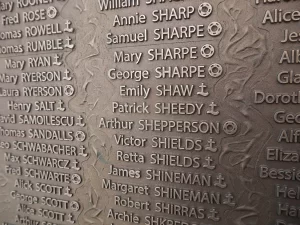 While there is a beautiful monument to the Lusitania in Cobh near Cork city, until we designed and built the “wave-sculpture,” there was no monument in Europe or America to commemorate all the crew and passenger of the Lusitania. The wave-sculpture is the centerpiece of a quiet, contemplative space, call the Lusitania Memorial Garden, situated in a recessed area to the south seaward side of the Signal Tower. The wave-sculpture is a 20-metre-long bronze monument on which the names of all the crew and passengers caught up in the tragedy of the sinking of the Lusitania on May 7, 1915 are inscribed, beginning with the name of the captain, William Thomas Turner. Beside each name is a symbol indicating whether the person was lost or saved. A walk along the breadth of the sculpture reveals the story of the ship beginning with the New York skyline as it was in 1915 when the Lusitania left pier 54 of the Hudson River and ending at Clonmel cemetery in Cobh where mass burials took place.
While there is a beautiful monument to the Lusitania in Cobh near Cork city, until we designed and built the “wave-sculpture,” there was no monument in Europe or America to commemorate all the crew and passenger of the Lusitania. The wave-sculpture is the centerpiece of a quiet, contemplative space, call the Lusitania Memorial Garden, situated in a recessed area to the south seaward side of the Signal Tower. The wave-sculpture is a 20-metre-long bronze monument on which the names of all the crew and passengers caught up in the tragedy of the sinking of the Lusitania on May 7, 1915 are inscribed, beginning with the name of the captain, William Thomas Turner. Beside each name is a symbol indicating whether the person was lost or saved. A walk along the breadth of the sculpture reveals the story of the ship beginning with the New York skyline as it was in 1915 when the Lusitania left pier 54 of the Hudson River and ending at Clonmel cemetery in Cobh where mass burials took place.
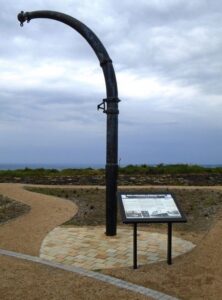 A few years ago, Newry and Mourne District Council, in Northern Ireland, generously donated an imposing and poignant artefact to the Lusitania Museum at Old Head. This is the davit of the Lusitania which is a lifeboat hoist from which one of the lifeboats was launched. It is about three metres tall with an arcuate, upper half, curved in the shape of a hook. It now stands within the Memorial Garden, on the piece of Irish soil nearest landfall to the wreck, with the point of its curve directing visitors’ gaze to the exact horizon where the wreck lies on the seabed. There is an explanatory plaque nearby detailing the history of the davit.
A few years ago, Newry and Mourne District Council, in Northern Ireland, generously donated an imposing and poignant artefact to the Lusitania Museum at Old Head. This is the davit of the Lusitania which is a lifeboat hoist from which one of the lifeboats was launched. It is about three metres tall with an arcuate, upper half, curved in the shape of a hook. It now stands within the Memorial Garden, on the piece of Irish soil nearest landfall to the wreck, with the point of its curve directing visitors’ gaze to the exact horizon where the wreck lies on the seabed. There is an explanatory plaque nearby detailing the history of the davit.
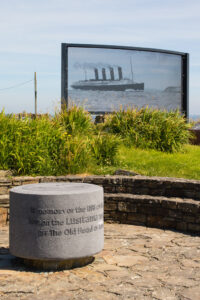 There is a third memorial in the Old Head Signal Tower grounds, visible from the roadside. It is an image of the Lusitania passing the Old Head on one of its voyages. The sculpture was created by drilling 35,000 holes of different diameters in a large, curved piece of stainless steel. The image is formed when the ambient light shines through contrasting holes of different sizes. The image is visible from both sides of the sculpture. The sculpture was also donated to us by a local Kinsale businessman. There is an original 1995 monument just adjacent to the grounds also.
There is a third memorial in the Old Head Signal Tower grounds, visible from the roadside. It is an image of the Lusitania passing the Old Head on one of its voyages. The sculpture was created by drilling 35,000 holes of different diameters in a large, curved piece of stainless steel. The image is formed when the ambient light shines through contrasting holes of different sizes. The image is visible from both sides of the sculpture. The sculpture was also donated to us by a local Kinsale businessman. There is an original 1995 monument just adjacent to the grounds also.
These monuments constitute the totality of the memorials which exist to commemorate the Lusitania. To do justice to the story of the Lusitania, we need a modern dedicated space to display the many artefacts in our possession. That is the Omega Point.


